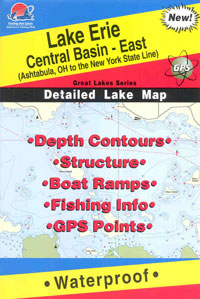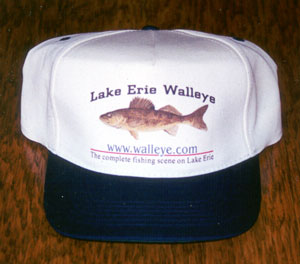| |
We've all been there. Cabin fever syndrome ... staring at the
walls crazy. We want to go fishing ... but we haven't been able
to ... until now! The time to
 start
is here, so let's get you started off on the right foot by
giving you a "spring-through-early summer" run-down of the
hottest locations, and latest techniques with the best tackle
choices for the new year. start
is here, so let's get you started off on the right foot by
giving you a "spring-through-early summer" run-down of the
hottest locations, and latest techniques with the best tackle
choices for the new year.
Rivers
can be the ticket in spring. Fish location is a real key, with
walleyes concentrating close to shore, during high current
conditions near swirling back eddies and slack water refuges. In
years of slow or moderate current flows the fish will relate to
the deeper main channel edges. Boat control is the most critical
part of a precise presentation needed to fool these current
orientated walleyes. It's desirable to match your boat speed to
the exact speed of the current by using a bursting technique to
compensate for winds and bottom contour changes. Minn Kota's
Genesis bow mount electric motor, with 74 lbs. of thrust, makes
this type of river fishing a breeze, even with the largest of
fishing rigs. Vertical jigging techniques rule during this cold
water time frame and arming oneself with the ideal weaponry to
do battle with these lethargic post winter fish is a must. A
Walleye Angler Signature Series jigging rod, a handful of
Northland Tackle's Buck-Shot Rattle Jigs, some Berkley Power Jig
Worms, minnows, stinger hooks and premium 6 lb. FireLine or
Trilene Premium Strength mono will be the right stuff to win a
few walleye wars.
Another
fantastic spring area is the shallows of both rivers and lakes.
Spawning areas are particularly productive as both males and
females relate to the gravel and stone substrate. Pitching 1/16
to 1/8 oz. FireBall Jigs along these rock studded shorelines
should prove to be a satisfying fishing experience. Walleyes
won't be the only thin water victims as many bass, sunfish, and
catfish go shallow this time of year. Sometimes our favorite
fish likes to spend time hanging around flooded timber and such.
Use the same jig pitching technique but vary the jig style to a
hook guarded Northland Weed Weasel. Throw the jig quite close to
shore, and retrieve with a lift, pause, lift, pause type of
stroke. Beginners and novices who have not yet garnered the
experience to positively identify a soft bite or that have a rod
that is not an expensive high-tech graphite model will have much
more luck with using no-stretch FireLine. For those experienced,
lightning fast reflex guys and gals, Trilene Premium Strength
mono will be your choice so as not to repeatedly pull the hook
out during your hard positive hookset.
As spring rolls
to summer, walleyes normally move deeper (10-15 feet) to the
breakline edges, down the slope and sometimes even to the bottom
edges. Offshore humps and long shoreline finger points dumping
to deep water all hold fish. One of the simplest, most deadly
methods for early summer walleyes is the Rock-Runner Bottom
Bouncer. Bouncers of the 1/4 to 1/2 oz range coupled with a 7
foot snell, bare hook and live bait, slow trolled with an
electric motor can literally fill the boat on certain days.
Another
great method for these mid-depth breakline orientated fish,
especially if they seem to be scattered along the break, would
be crankbaits. Using a Mercury 4-stroke kicker (9.9 -15 hp)
outboard to troll ultra-slow, maintaining a constant depth is
called contour cranking and can be devastatingly effective.
Normally this will be a numbers game, in effect, trolling
crankbaits such as Storm DTS09 Deep ThunderSticks and Rapala #7
Shad Raps past hundreds of fish to get one bite. Surprisingly
there are times that walleyes will congregate on a reef by the
thousands making for a quick limit even when bucking the numbers
odds. During contour cranking you are concentrating on a fairly
narrow fishing zone, "along the break", so make the lure spread
with 3 rods. Two 8 foot 6 inch trollers out the side, in the rod
holders and a 7 foot 6 inch hand held version directed behind
the boat (check local regulations for number of rods allowed per
angler).
Trolling is an
awesome early summer tactic, but let's switch to another
location. Shallow flats. By definition, these areas will be
relatively structure free, but as far as overall lake depth is
concerned, definitely not in the deepest part. For instance, in
natural lakes a good flat might be from 8-10 feet deep while in
Lake Erie we may be talking 30-40 feet. The first overlooked
trolling technique is using the same rod setup discussed earlier
but adding a fourth 7 foot 6 inch troller. Lines will be spread
using Offshore Planer boards and on natural lakes bottom
bouncers with Northland 3-D Rainbow Spinners baited with
crawlers. When the water is clear, choose blades that are shiny
and emit a lot of flash.
Deeper Great
Lakes flats will often find the walleyes suspended, making the
use of open water type spinners imperative. These spinners are
still baited with crawlers but sport treble hooks instead of
singles for better hooking power. Suspended walleyes feed in an
upward direction which means replacing bottom bouncers with Off
Shore Snap Weights. When the fish are close to bottom use a 10
foot lead on a Open Water Spinner, attach the Snap Weight and
drop the offering just above the depth finder's "hooks" you're
marking. If they are suspended higher in the water column, make
the lead longer (50-100 feet- depending on water clarity) before
attaching the Snap Weight.
Whenever the
fish are setup on flats it's very important to locate them
electronically. Usually there are no structural marking points,
so schools of walleyes must be found and marked by using a
combination of sonar and GPS. Units like Lowrance's LCX-15MT,
that combine sonar and GPS in one unit, are great for this.
Cruise the proposed fishing area with sonar, marking likely
looking areas with GPS icons, but use a non fish symbol to mark
the potential school. Once the area is scoped out, go back and
fish in the vicinity of the icons. When you catch a walleye,
drop a fish icon, and work the area thoroughly, dropping more
fish icons for each walleye caught. This way a school location
will become quickly apparent.
The last early
summer technique is the probing of these same open water flats
with planner boards and crankbaits. As the water warms to 50
degrees and above, walleyes will turn to cranks. Subtle action
baits like ThunderSticks and Rapala Husky Jerks work well in
cold temps and moderate action baits like Shad Raps or the new
ThunderCranks take over when water is on the warm. In clear
water use chromes and natural colors. Dingy water dictates
FireTiger or other bright colors.
We think that
you'll find the summary of spring and early summer techniques
and locations helpful this year. Fishing season is almost upon
us, so sharpen those hooks, and spool up some fresh line ...
cabin fever can't last much longer! |





 start
is here, so let's get you started off on the right foot by
giving you a "spring-through-early summer" run-down of the
hottest locations, and latest techniques with the best tackle
choices for the new year.
start
is here, so let's get you started off on the right foot by
giving you a "spring-through-early summer" run-down of the
hottest locations, and latest techniques with the best tackle
choices for the new year.